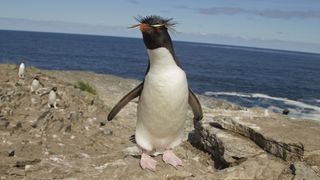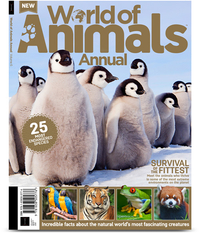Adorable 'confused penguin' charms the internet: What really happened?
The little rockhopper nearly hopped away with the wrong group.
If you've ever lost track of your friends in a crowd, you'll likely empathize with the endearingly "confused" rockhopper penguin in a recent viral video. The bird became separated from a penguin group and began hopping away with a bunch of strangers; however, a penguin from the first group seemingly goes back to collect the stray, and everyone enjoyed a very hoppy ending.
The footage was posted on Jan. 9 by The Southern Barlows, a YouTube channel that shares clips of life in the Falkland Islands (also known as Islas Malvinas), according to an account description. The Falklands are an archipelago in the Atlantic Ocean off the southern coast of Argentina, and approximately 320,000 breeding pairs of southern rockhopper penguins (Eudyptes chrysocome chrysocome) gather there annually from October until April, according to Falklands Conservation.
In the short video, one group of penguins bounces energetically downhill, probably going to the sea to fish, said Klemens Pütz, scientific director of the Antarctic Research Trust in Bremervörde, Germany. The mix-up happens when the penguins encounter and briefly mingle with a second group hopping in the opposite direction, likely returning from the ocean and heading back to the breeding colony, Pütz told Live Science.
Related: Charming chick photos: Antarctica's baby penguins
Rockhoppers arrive at their Falkland Islands breeding grounds in October, and lay their eggs by mid-November, Pütz said. Chicks hatch about a month later and fledge by the end of February. Once breeding season ends, the parents molt and embark on their winter foraging journey. They stay exclusively at sea for six months and swim thousands of miles, dispersing south from coastal waters near the Falklands to the Straits of Magellan and Cape Horn, and to the north along the Patagonian Shelf, Falklands Conservation reported.
Even though the "confused" penguin in the video seems temporarily unable to tell which group is the right one, rockhoppers can identify their mates and chicks among tens of thousands in a colony, said Nicolás Alejandro Lois, a researcher and doctoral candidate at the Institute of Ecology, Genetics and Evolution of Buenos Aires. The birds find each other mostly by using call-and-response vocalizations and visual cues, during which "they stop, stand up straight and turn their heads around," Lois told Live Science in an email.
Rockhopper males and females pair up for several years (as happens in many penguin species), and some evidence suggests that they find each other by meeting at the same nest site every spring, "since the partners spend the winters separately," said Nina Dehnhard, a seabird ecologist with the Norwegian Institute for Nature Research in Trondheim, Norway. That habit could explain why rockhopper penguins have a lower "divorce-rate" than emperor penguins, "which do not have a fixed nest site," Dehnhard said in an email.
Sign up for the Live Science daily newsletter now
Get the world’s most fascinating discoveries delivered straight to your inbox.
World of Animals Annual: <a href="https://www.awin1.com/awclick.php?awinmid=2961&awinaffid=103504&clickref=hawk-custom-tracking&p=https%3A%2F%2Fwww.magazinesdirect.com%2Faz-magazines%2F6942549%2Fworld-of-animals-annual-volume-6.thtml" data-link-merchant="magazinesdirect.com"" target="_blank">$22.99 at Magazines Direct
The animal kingdom is a fascinating, beautiful and complex world, but it faces an uncertain future. In the past few years, we’ve seen Japan resume whaling and scientists warn that the next decade could prove pivotal for the Earth’s environment and its inhabitants. This annual explores some of the threats faced by 25 of the world’s most endangered creatures and meets the animals that owe their continued existence to the vital <a href="https://www.livescience.com/54707-endangered-species-act.html" data-link-merchant="livescience.com"" data-link-merchant="magazinesdirect.com"" target="_blank">Endangered Species Act of 1973.

When the penguins spend their breeding months in colonies, they often gather in small groups like those seen in the video, because trips to and from the ocean are safer with company. But there's no special bond between birds in such groups — they simply happen to be heading in the same direction at the same time, Pütz told Live Science.
"They're just a mixture of penguins. And next time, they're in a completely different group," Pütz said. When penguin groups heading in different directions run into each other, "confusion usually arises," Lois said in the email. "They are always prone to follow others, and that is always stronger than the original direction."
And while the briefly disoriented penguin in the video did seem to receive some help from a concerned rockhopper, it's unlikely that the second penguin was truly demonstrating altruistic behavior. Rather, it was probably just as confused as the first, Pütz said.
"I think it is just coincidence and appears to the human eye as if one of the penguins helps the other and gets him back on track," he said.
Originally published on Live Science.

Mindy Weisberger is an editor at Scholastic and a former Live Science channel editor and senior writer. She has reported on general science, covering climate change, paleontology, biology, and space. Mindy studied film at Columbia University; prior to Live Science she produced, wrote and directed media for the American Museum of Natural History in New York City. Her videos about dinosaurs, astrophysics, biodiversity and evolution appear in museums and science centers worldwide, earning awards such as the CINE Golden Eagle and the Communicator Award of Excellence. Her writing has also appeared in Scientific American, The Washington Post and How It Works Magazine.

